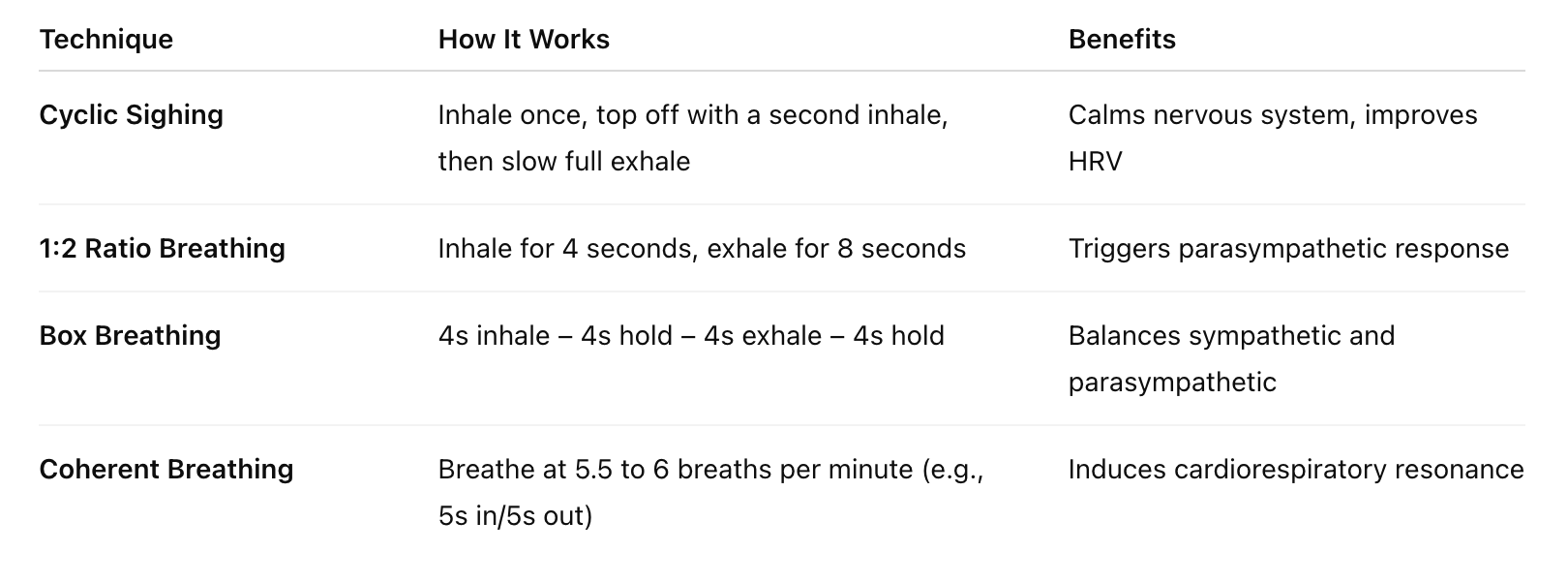Breathing: The Two Halves of Life
By: Courtney G. Clifford
Breath is the simplest gift of life—yet its two halves, inhale and exhale, serve very different roles.
Inhale: expands the lungs, activates the heart, signals “go” to the body.
Exhale: empties the lungs, restricts space around the heart, triggers calm, a powerful release.
If you’ve ever noticed your chest relax after a long exhale, that’s not just subjective—it’s physiological.
The Power of the Exhale: A Science-Backed Path to Calm and Resilience
Breathing is the most fundamental human activity—automatic, rhythmic, and deeply tied to life itself. Yet most of us take it for granted, especially when it comes to how we breathe. While both inhalation and exhalation serve vital functions, science is increasingly uncovering the unique power of the exhale as a tool for regulating the nervous system, improving heart health, and cultivating mental clarity.
This blog post explores the science behind the exhale—how and why it calms us, what physiological changes occur during long exhalations, and how a simple shift in your breathing habits can transform your daily life.
Breathing 101: Two Sides of a Cycle
Each breath consists of two parts: inhale and exhale. These aren’t just mechanical movements; they serve distinct physiological roles:
Inhale: Activates the sympathetic nervous system (the “fight-or-flight” response), expands the lungs, and increases heart rate slightly.
Exhale: Engages the parasympathetic nervous system (the “rest-and-digest” response), compresses space in the chest cavity, and slows the heart.
The balance between these systems is what determines how well we can adapt to stress, rest effectively, and regulate our emotions. In particular, the exhale appears to be a crucial lever in tilting the body toward calm and recovery.
Why Exhalation Calms the Nervous System
1. Parasympathetic Activation via the Vagus Nerve
The vagus nerve plays a major role in regulating the parasympathetic nervous system. During a slow or prolonged exhale, vagal tone increases, which slows the heart rate and signals the brain to enter a state of calm and safety. This is partly due to changes in intrathoracic pressure: as we exhale, pressure in the chest increases slightly, which stimulates baroreceptors (pressure-sensitive sensors) and further engages the vagus nerve (Laborde et al., 2022).
2. Heart Rate Variability (HRV) and Emotional Resilience
One of the clearest markers of parasympathetic activity is heart rate variability (HRV)—the variation in time between heartbeats. Higher HRV is associated with better stress resilience, improved emotional regulation, and lower risk of cardiovascular disease. Multiple studies show that slow breathing—particularly when it includes extended exhalation—can significantly improve HRV (Lehrer & Gevirtz, 2014; Zaccaro et al., 2018).
The Science of Big Exhales
You might intuitively know that sighing or exhaling deeply helps you feel better, but science supports this idea.
Cyclic Sighing
A recent randomized controlled trial by Balban et al. (2023) at Stanford University found that just five minutes per day of cyclic sighing—a breathing technique that involves a double inhale followed by a long, slow exhale—produced greater reductions in anxiety and stress than either mindfulness meditation or box breathing. Not only did participants report feeling calmer, but they also showed improved physiological markers such as HRV and reduced respiratory rate.
Exhale-to-Inhale Ratios
Breathing exercises that intentionally lengthen the exhale (such as a 4:6 inhale-to-exhale ratio) have been shown to enhance parasympathetic tone and increase HRV more than equal-ratio breathing (Komori et al., 2018). This aligns with the body's natural rhythms: when exhalation is emphasized, the nervous system is given more time to activate its calming mechanisms.
Physiological Mechanisms Behind the Calm
Baroreflex Sensitivity
One lesser-known but important mechanism is the baroreflex, which helps maintain stable blood pressure. Slow, deep exhalation increases baroreflex sensitivity, meaning the body becomes better at detecting and responding to pressure changes in the cardiovascular system. Improved baroreflex sensitivity is linked to reduced blood pressure, better heart function, and improved autonomic balance (Joseph et al., 2005).
Cardiorespiratory Resonance
Breathing at a rate of around six breaths per minute—typically with extended exhalation—promotes a state known as cardiorespiratory resonance. In this state, the heart rate, respiration, and blood pressure rhythms align, amplifying the effects of each other and resulting in maximal increases in HRV (Shaffer et al., 2014).
Health Benefits of Exhalation-Focused Breathing
Reduces Stress and Anxiety
Longer exhalation lowers cortisol levels, slows the heart rate, and signals safety to the brain.Improves Cardiovascular Health
Enhanced HRV and baroreflex sensitivity from slow breathing are associated with better heart function and reduced blood pressure.Enhances Focus and Emotional Regulation
Improved vagal tone correlates with better mood, sharper cognition, and more effective emotion regulation.Boosts Sleep Quality
Many people report falling asleep faster and sleeping more deeply when practicing slow breathing or cyclic sighing before bed.
Try It Yourself: Exhalation Techniques
You don’t need a meditation cushion or special training to benefit from exhale-based breathing. Here are a few easy techniques to incorporate into your daily life:
Tips for Success:
Start with just 2–5 minutes per day.
Sit or lie comfortably with a straight spine.
Focus on breathing through the nose.
Allow the exhale to be longer, slower, and more complete.
Why the Exhale Deserves More Attention
The inhale often gets glorified as the “energizing” part of the breath—and rightly so. But the exhale is where we find release, regulation, and recovery. In a world driven by constant stimulation, learning to extend and soften your exhale is like applying the brakes to a runaway train.
When you focus on the exhale:
You slow down time, even just for a moment.
You reconnect to your body’s rhythm.
You engage the parts of your nervous system designed to restore and rebuild.
Conclusion: One Exhale at a Time
Modern science and ancient wisdom both point to the same truth: exhalation is a powerful tool for calming the mind, regulating the body, and cultivating resilience. Whether you’re feeling stressed at work, anxious before bed, or just needing to ground yourself in the present, remember this simple practice:
Inhale… then exhale, slowly and completely.
It might be the most underrated—and most accessible—wellness tool you have.
References
Balban, M. Y., Rutledge, R. B., Marusak, H. A., & Huberman, A. D. (2023). Effects of different types of breathwork on mood and physiological arousal. Cell Reports Medicine, 4(3), 100912. https://doi.org/10.1016/j.xcrm.2023.100912
Joseph, C. N., Porta, C., Casucci, G., Casiraghi, N., Maffeis, M., Rossi, M., & Bernardi, L. (2005). Slow breathing improves arterial baroreflex sensitivity and decreases blood pressure in essential hypertension. Hypertension, 46(4), 714-718. https://doi.org/10.1161/01.HYP.0000179581.68566.7d
Komori, T., Umezaki, M., & Usui, A. (2018). Effect of slow breathing with long exhalation on stress and autonomic function in healthy adults. International Journal of Behavioral Medicine, 25(4), 454–460. https://doi.org/10.1007/s12529-017-9696-4
Laborde, S., Hosang, T. J., Mosley, E., & Dosseville, F. (2022). Influence of voluntary slow breathing on heart rate variability and responses to stress: A systematic review and meta-analysis. Neuroscience & Biobehavioral Reviews, 138, 104715. https://doi.org/10.1016/j.neubiorev.2022.104715
Lehrer, P. M., & Gevirtz, R. (2014). Heart rate variability biofeedback: How and why does it work? Frontiers in Psychology, 5, 756. https://doi.org/10



